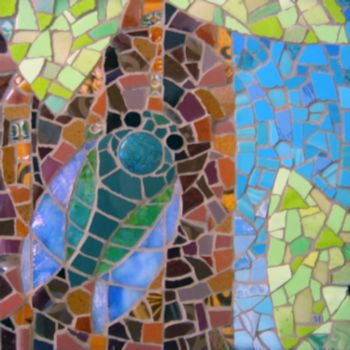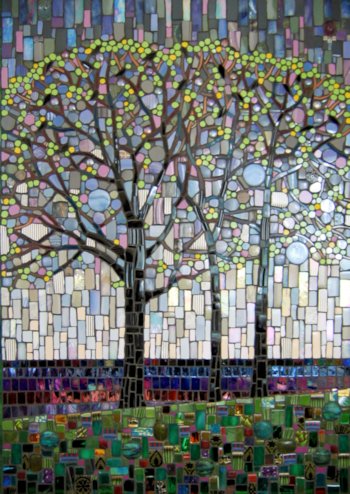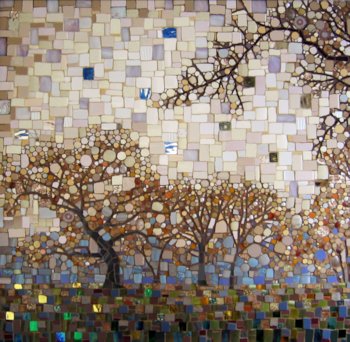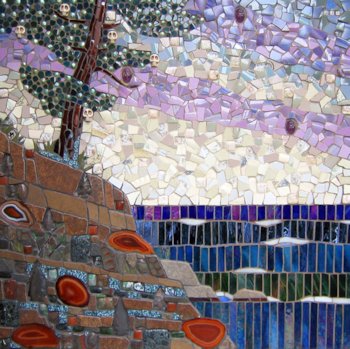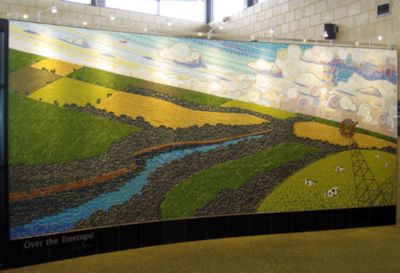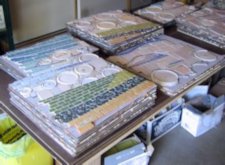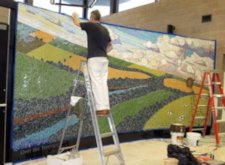|
KYSO Flash ™
Knock-Your-Socks-Off Art and Literature
|
|
|||
Four Mixed-Media Mosaicsby Michael Sweere, Featured Artist
Copyright © by Michael Sweere. All rights reserved.
Copyright © by Michael Sweere. All rights reserved.
Copyright © by Michael Sweere. All rights reserved.
Copyright © by Michael Sweere. All rights reserved. Commentary by Michael SweereI’ve always wanted to be an artist—I’ve known this since I was quite young. After graduating from high school I attended Mankato Technical Institute and received a degree in “Commercial Art.” I moved to Minneapolis in 1986 and worked as a production artist for several small advertising agencies and design studios. My flexible schedule allowed me to train at The Atelier Bougie, studying classical drawing and painting. * For the next 15 years the commercial world took precedence over my fine-art passion. I advanced my career, became an art director, and worked for several large firms. In 2005, I was awarded my first commissioned mosaic assignment. This opportunity allowed me to resign from advertising and to establish the Michael Sweere Mosaic Company; and I’ve been creating original artwork on a full-time basis ever since. I work in several media: drawing, painting, mosaics, and collages. Much of my work incorporates recycled and salvaged objects—locating this material is a favorite pastime. I frequent salvage and thrift stores looking for dinner plates, tin objects, old books, lumber, and ceramic tile. Often, my creative process unfolds with the discovery of new materials. It’s fun, it’s unpredictable, and it always keeps things fresh. [* The Atelier Bougie was co-founded by Peter Bougie in 1988, was later renamed The Bougie Studio, and closed in 2003. For those interested in more information, links are included under “More on the Web” below.] Editor’s Note by Clare MacQueenLast spring, during one of my RAO sessions (i.e., rootin’ around online), an insect shimmering with ice-blue wings and turquoise carapace caught my eye. This unique creature was the subject of a mosaic “painting” entitled Cicada—and I was captivated. Not only by the colors, but also, how often are creepy crawlies like the “tree cricket” the subject of fine art? (Little did I know!) As one who is fascinated by “prettier” bugs such as honey bees, I just had to see more by this artist. One link led to another, and I soon fell willingly into the vortex of Michael Sweere’s quirky collages and lush yet elegant landscapes, where I was glad to linger over their nuances of light and shadow. And to marvel at their creative upcycling of discarded and found objects. Sweere’s works incorporate a range of media which are typically ignored by the majority of other fine artists: vintage buttons and pearls, pebbles and agate slices, broken plates and ceramic tiles, tin cans and cookie tins—even salvaged paper products, such as cereal boxes and UPC codes. One of the mosaics reproduced above, Gichigami (the Ojibwe name for Lake Superior), incorporates skull-shaped beads—which I speculate may refer obliquely to the historical practice by some indigenous peoples of burying their dead on scaffolds or in trees. Or maybe the skulls symbolize the spirits of sailors drowned in shipwrecks. Sweere also populates his mosaic landscapes, both natural and urban, with depictions of various denizens of forest and lake—fin, feather, fur, and fern. Other insects appear as well: fireflies, dragonflies, and even a beetle or two. Within 24 hours of discovering Sweere’s works, I was thrilled to receive permission from the artist to include four of his images in KYSO Flash’s first issue—plus, the journal’s color scheme was in place on the drawing board: shades of blue, green, and burgundy-brown inspired by Cicada. (And, of course, by the golden-green trees in Victor Nunnally’s stained-glass mosaic, Journeyman #4, which graces our home page.) Compared to Sweere’s exquisite interpretation, the real-life cicada looks downright ugly. Yet these red-eyed rock stars of the insect world, whose buzz can reach 105 decibels, remind me of sweltering afternoons spent as a teen playing outdoors with my siblings in the Sandhills. Which is why I understand when Sweere says: “I love cicadas. To me, they are the soundtrack of late summer. I associate them with August and the buzz they create takes me back to my childhood.” At eight inches by eight inches, Cicada may be the visual-arts equivalent of a prose poem, yet Sweere enjoys working at the epic scale as well. His largest work thus far, Over the Treetops! is about 8 feet tall by 18.5 feet wide. The piece was installed in June 2014 at the Fort Dodge Municipal Airport in Iowa.
“Constructed from salvaged ceramic and porcelain tile and broken dishware,” as Sweere wrote in email, “it took me three very long months to build the mosaic and about one week to install.” He described the process this way: I built it piece by piece in my studio. The mosaic was constructed on 36 individual flexible, fiberglass mesh sections—each approximately 24 inches by 24 inches. When it came time to transport, I was able to fit all 36 sections and my tools in one truck. The actual commute was a bit like “driving the dynamite truck”—[but once the mosaic was] at the site and unloaded, I was able to relax. The 36 sections were then re-assembled in order, like a big jigsaw puzzle, and attached to the wall with concrete mortar, grouted, polished, and sealed. The trickiest part is working with the builders to make sure that the wall is square and prepared properly—then making sure the measurements all add up. I’ve done several big wall installations and every time I learn new tricks. — From email of 24 June 2014; published here by author’s permission
Michael SweereIssue 1, Fall 2014
Formerly a production artist in commercial advertising, Sweere received his first mosaic commission in 2005. As his website bio says, much of his work “incorporates recycled and salvaged objects....” and his “original collages, mosaics and paintings can be found in numerous corporate, private, and public collections.” His work also has been featured in Art & Antiques (“Emerging Artist,” May 2004) and Mosaic Art NOW. More on the Web: By, About, and Beyond⚡ Lakes, Panel 3 of 4, from an installation created with discarded paper packaging; resides at The Mayo Clinic in Rochester, New York
⚡
Michael Sweere 2008
Grantee by the Forecast Public Art Group ⚡ A Man and His Mosaics: “Owatonna Native Michael Sweere Stumbled onto a Profession in the Art World Starting with, of All Things, Cereal Boxes” by Melissa Kaelin in Owatonna People’s Press (22 August 2010)
⚡
Interview With Michael
Sweere: An Artist Who Creates Modern Fine Art From Reclaimed Materials in
E-JUNKIE.INFO (12 April 2011)
⚡ Several of Sweere’s small-scale works, including Cicada, are available for purchase through Sivertson Gallery. ⚡ About Peter Bougie, North American Classical Realism painter; gallery page includes four landscapes (oil on panel) ⚡ The Bougie Studio: Continuing a Long Tradition of Training Painters by Peter Bougie; this detailed curriculum description was originally published in 1998 in Resource Library Magazine.
⚡
Mosaic? Post-Mosaic?
Neo-Mosaic? Non-Mosaic? by art consultant and mosaic scholar, Daniele Torcellini,
an expert in the history and use of color. Translated by Julie Richey, this brief
discourse of 1400 words (plus, seven photographs) answers questions such as:
⚡ The 17-Year Itch by Phil Plait in Slate’s Bad Astronomy blog (28 May 2013); includes Return of the Cicadas, a creepy yet fascinating time-lapse video about seven minutes long, by filmmaker Samuel Orr |
||||||||||||||
|
Site contains text, proprietary computer code, |
|
| ⚡ Many thanks for taking time to report broken links to: KYSOWebmaster [at] gmail [dot] com ⚡ | |
